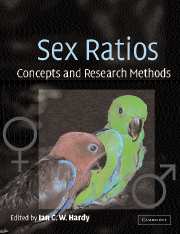Book contents
- Frontmatter
- Contents
- List of contributors
- Preface and acknowledgements
- Part 1 Sex ratio theory
- Part 2 Statistical analysis of sex ratio data
- Part 3 Genetics of sex ratio and sex determination
- Part 4 Animal sex ratios under different life-histories
- Part 5 Sex ratios in plants and protozoa
- Part 6 Applications of sex ratios
- Chapter 18 Operational sex ratios and mating competition
- Chapter 19 Using sex ratios: the past and the future
- Chapter 20 Using sex ratios: why bother?
- Index
- References
Chapter 18 - Operational sex ratios and mating competition
Published online by Cambridge University Press: 06 August 2009
- Frontmatter
- Contents
- List of contributors
- Preface and acknowledgements
- Part 1 Sex ratio theory
- Part 2 Statistical analysis of sex ratio data
- Part 3 Genetics of sex ratio and sex determination
- Part 4 Animal sex ratios under different life-histories
- Part 5 Sex ratios in plants and protozoa
- Part 6 Applications of sex ratios
- Chapter 18 Operational sex ratios and mating competition
- Chapter 19 Using sex ratios: the past and the future
- Chapter 20 Using sex ratios: why bother?
- Index
- References
Summary
Summary
This chapter deals with the operational sex ratio (OSR) and its importance for understanding mating competition, which is a key component of sexual selection. We focus on OSR as an empirical measurement with important applications in sexual selection, but we also pay considerable attention to the question of how to estimate sexual differences in potential reproductive rates (PRR). The sexual difference in PRR and the adult (or qualified) sex ratio are the most important factors influencing the OSR, and thus the pattern of sexual selection in a population. We illustrate our points using examples from a wide range of taxa. In particular, we investigate how environmental factors, through their effects on PRR and OSR, often add a dynamic to mating competition, which sometimes results in different sex roles and varying intensities being displayed in different populations or at different times within a breeding season. Finally, we consider some examples of contrasting patterns, how OSR relates to mate choice and prospects for further research.
Sexual selection
Males of many animals have evolved conspicuous traits that seem to reduce their survival. Darwin (1871) proposed the theory of sexual selection to explain the evolution of such traits. Sexual selection arises through competition over mates or matings, and assumes that individuals with a certain trait, whether a red tail or a specific behaviour, will have an advantage when competing for matings.
- Type
- Chapter
- Information
- Sex RatiosConcepts and Research Methods, pp. 366 - 382Publisher: Cambridge University PressPrint publication year: 2002
References
- 45
- Cited by



